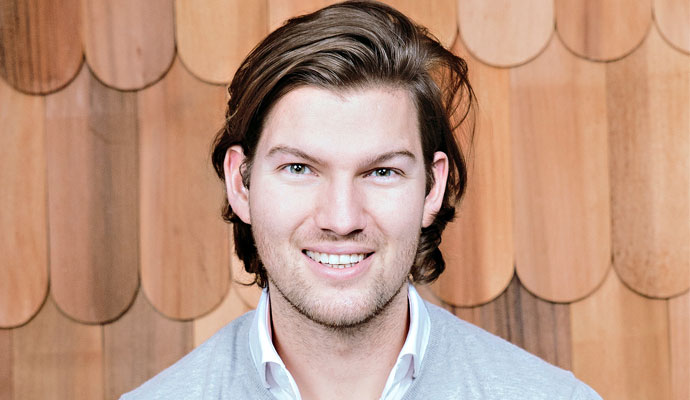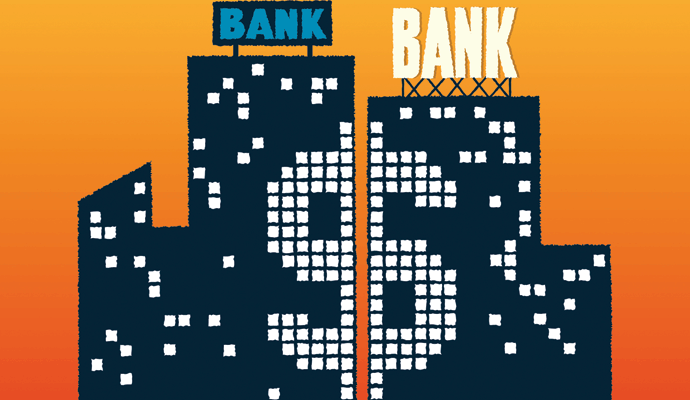How can a fintech company win 20 million customers?
Valentin Stalf, chief executive of German financial-services startup N26, wants banking to be like music downloading.
This interview is part of the Inside the Mind of the CxO series, which explores a wide range of critical decisions faced by chief executives around the world.
How long will it be before the new financial technology (fintech) companies transform the financial-services industry? To startup fintech leaders such as N26 CEO Valentin Stalf, that may be the wrong question. They want to know how long it will take to transform people’s everyday experience — in particular, the way they organize their lives and prepare for their financial future.
A consumer bank accessible only through a mobile app, N26 has been described as offering the most modern bank account in Europe. Based in Berlin, it has no branches or ATMs of its own, but customers can get cash at any ATM or at 7,000 affiliated retailers. N26 is sometimes described as targeting millennials, who tend to be easily frustrated when it comes to financial services. One study, the 2017 Millennial Disruption Index, found that 71 percent of the respondents would rather visit the dentist than their local bank branch.
Stalf, born in 1985, is a millennial himself. He and his colleagues at N26 believe that people of all ages are ready for digitally enabled simplicity and seamlessness, especially in personal banking. (“Why can’t we ‘Spotify’ banking?” he asks.) N26’s strategy is to combine all the complexity of an individual’s financial life — with accounts and cards from many companies — into a single, relatively simple financial-services platform, using cross-service partnerships and alliances to expand the services it offers. Its current partnerships with Mastercard, Clark for insurance, TransferWise for money transfers, and Auxmoney for credit lines represent first steps toward the larger business ecosystem that Stalf plans to create.
Raised in Vienna, Stalf got involved in fintech after pursuing a master’s degree in accounting and finance at St. Gallen University in Switzerland. In 2012, after a stint at an investment bank, he moved to Berlin and joined a tech incubator called Rocket Internet to work on fintech-related projects. That’s when he started to learn about the challenges traditional banks face when it comes to digitization. He launched his startup about a year later, in 2013, with his boyhood friend Max Tayenthal. Tayenthal, a lawyer, was well-accustomed to the highly regulated environment of the European financial-services industry.
N26 currently has about 550,000 users in Europe — primarily in Germany, Austria, France, Spain, and Italy. That’s a fraction of what an established consumer bank manages, but the bank is adding about 2,000 users per day, often at a low cost compared to more established banks. In 2018, N26 will open business in the United States and United Kingdom. Stalf met with strategy+business at the N26 offices in Berlin, where he talked about the digital generation’s changing financial habits and the “Spotification” of banking.
S+B: What did you see that led you to launch N26?
STALF: Our starting point was the poor quality of other digital banking products. In e-commerce and entertainment, the experience is mobile-friendly and easy to use. Most banking products are really difficult for customers, and no one enjoys interacting with them.
People’s financial lives are so important because they are the basis for all decisions. If you want to buy something, go on holiday, or plan for the future, your ability depends on your budget and cash flow. But most banking products today are not conducive to understanding your financial lives and making good decisions that build good habits.
We decided to create a bank that people would use, not because they had to, but because they really loved to open the software and engage with it. We got our own banking license, because we didn’t want the constraints that would come if we were part of another banking group, with partners who would tell us what to do or what rules to follow. If you want to put forward a very simple product that people love to use, you can only do it when you own the technology and govern yourself.
“If you want to put forward a very simple product that people love to use, you can only do it when you own the technology and govern yourself.”
We also looked at the overall technology trends. Cashless payments, which had been the centerpiece of many fintech efforts, were on the decline. But smartphone use was more prolific every year. The quality of smartphones was also continuously improving. This was one of the biggest drivers for our timing. If we had started the company three or four years earlier, the N26 app experience would not have been that great. Today, due to advanced programming languages and more sophisticated devices, you can offer more complex products on the phone and differentiate your app.
S+B: How are these new products different from conventional banking?
STALF: Most people don’t want to spend too much time on their financials. About 80 percent of our users just want to have their financial lives set up to be easy to deal with. So, our focus today is on quick wins: easy transactions on the smartphone. People want to save time. They want to do their banking with a couple of clicks. No one wants to spend two hours opening a bank account. No one wants to set up a standing order where you need to type in five different codes that you keep offline, on paper. People also want to lower the barrier of financial literacy so they can make better decisions. And they want a full range of banking products, the best that anyone could find.
In the end, as long as there is trust and quality, users don’t care too much where the products come from. So we built a marketplace where we integrate partners from around the world. They include traditional and modern players. We’re independent of these partners, and we try to curate the best products for our customers. It’s about fair products and transparency. It’s not about searching two hours on the Internet to find someone who will give you 0.3 percent lower interest rates.
S+B: Do your customers help determine what products or partnerships you offer?
STALF: Partly, yes. We have a functionality in the app where you can submit ideas or request a feature or product. We try to deeply understand what the user is trying to accomplish with that request. When a user asks for a shared account, for example, a bank will traditionally interpret that as having two account numbers, held by two spouses, where one person signs and the other has access. The bank will come at it from a legal and technical perspective instead of an experiential one. But if you look deeper, you’ll find that a shared account is actually about two people wanting a shared space to book things and make financial decisions together.
I think this is why we are acquiring customers at a much cheaper cost than any traditional banks. People are very “sticky” with us. We don’t lose them. They don’t turn away. They do more transactions each month, and I’m very happy on that score.
S+B: What kinds of people are ready to switch to banking this way? Is it largely millennials?
STALF: I prefer to call our target audience “digital customers.” They exist in every age group. We see two trends that justify this behavioral change. First, people want something easy to use that will save them time. Second, they no longer tolerate restrictions. They can shop on Amazon with one click; they get instant access to music with Spotify. But the banking experience is still mostly like it was 20 years ago. You make a request, and maybe two weeks later something arrives. Our customers don’t understand why they should go to a bank branch to open an account, or why they need to fill out five forms to make an investment. They want ease of use and they want banks to customize products to their needs.
S+B: How do you see financial services evolving?
STALF: In the future, your banking practices will be driven by your individual profile and the actions you have taken in the past. If you have just recently got a new job, we know you have different financing needs from someone who has had a job for 20 years. Already, we are categorizing all the transactions of our customers, and creating profiles to understand their life situations. We currently use this for fraud management and risk-scoring. If we see unusual patterns in our transactions that suggest fraud, we can block the crime before it happens. In the future, we will use similar methods to serve each customer’s individual needs.
S+B: Do you mean offerings based on predictive analytics?
STALF: Yes. There will be a thousand financial-services products, all customized to each individual’s portfolio. Individualized screens will result in individual offerings based on your financial behavior.
Financial-services firms will increasingly use big data to understand what people are trying to do, and then tailor the experience accordingly. You want a savings product, and you don’t have €100,000 — but you have €10,000, so you are offered a different product. You apply for credit, and the data is already gathered: You don’t have to type in what you paid for your house. The trend is to reduce complexity, and to save consumers time while offering them comprehensive products that solve problems.
S+B: How will platform-based companies like N26 manage data privacy?
STALF: We will share data for verification — for instance, to make sure, from a regulatory perspective, that we have correctly identified the person who does a transaction. But we won’t give our partner companies full access to data for marketing. For example, we won’t give TransferWise a list of people and say, “Select the ones you want to approach, and your offer will pop up in their app.” Banks will have to become gatekeepers for their customers.
S+B: What are the biggest threats that could affect your business?
STALF: Talent is the key. Our biggest opportunity cost today is that we don’t always get the right people. And it’s especially true for tech and online jobs. The education system is much slower than the transformation on the tech side, so people are still studying offline marketing when we need hundreds of people working in online marketing. We don’t have enough software developers. If we could hire 200 highly skilled people tomorrow, we’d do that. We’re fortunate because, as a startup, we’re solving an interesting problem. We offer freedom and creative opportunity to our employees. Anyone who wants to work in the Berlin startup space has heard of us. And yet, access to talent is still an issue. It is an issue for all the fintech companies.
The other threat is access to capital. Although money is flowing into fintech, it’s only enough if you want to expand to reach, say, 20 million customers. But for fintech companies to ultimately reach 100 million users, there needs to be more capital.
S+B: In PwC’s 21st CEO survey, respondents said the best growth market is the U.S. right now. Do you agree?
STALF: Our best markets for N26 are always the countries where banking products have very bad usability and are very expensive. France, Germany, Italy, the U.K., and the U.S. are the most exciting opportunities for us. In all these places, there are very few true competitors. There are fintech startups, but they tend to be limited; we are the only digital product we know of that is a full replacement for a bank.
In Europe, right now, other fintech companies have up to 200,000 customers. N26 has more than 550,000 and we are aiming for 2 or 3 million customers soon. Then the next step will be to build toward 5, 10, or maybe 15 million customers in Europe. At that point, fintech will no longer be a niche phenomenon there. Some of the leading players in the industry will be fintech companies. And in the United States right now, there is a huge opportunity.
S+B: What about Asia?
STALF: Asia is more advanced. Many of its countries are dominated by a couple of players, WeChat being a huge one. Their tech companies have good contacts in government, which results in favorable regulation. They can release good products more quickly than European companies. India already has more advanced products on the market.
S+B: What about competition from social media?
STALF: Facebook and Google want to disrupt the way people pay and send money, but they are not yet involved in the management of daily financial life. I think in the end, the technology industry is going more in the direction of WeChat, which combines social media, payments, and broader financial services.
Ultimately, a bank is a place where you securely hold your identity and your money. On the Internet, one of the biggest problems is identity and payment fraud. It makes a lot of sense to have a single identity profile that identifies you, allows you to pay for things, manages your investments, and keeps your assets available. In the future, that could be a profile you manage through N26. Right now we’re focused on the simple problems: opening an account, setting up a standing order, and getting credit. In Germany, we already offer most of the products customers expect from a retail bank, and our goal is to expand this offering to all of our markets.
S+B: You’ve set yourself up as a platform for offerings from other companies. Meanwhile, large banks are starting to partner with fintech companies — or acquire them. Is your strategy competitive or collaborative?
STALF: We don’t care. We want to deliver the best product for our customers, which means sometimes we integrate with more traditional banks, and other times with fintech services. It comes down to whoever has the best product. Most of the time that’s fintech startups. In the U.S., it’s easier to start with a white-label partner [a producer of products and services for other companies to rebrand as their own], because mainstream banking is in a relatively advanced state. There are more competitive fintech offerings to choose from. In Europe, we’ve found that the terms and products aren’t as advanced. In any place, at some point we need to get our own banking license.
When it comes to payments, there is almost a monopoly on card transactions around the world. Visa and Mastercard own a huge percentage of the market. That’s why it’s very hard to make a marginal profit from card transactions, at least in Europe. On the other hand, this gives us the opportunity to expand globally quickly. I think the biggest problem credit card brands are facing today has to do with their user base. Over the next 10 to 15 years, more users will begin to bypass credit cards and pay directly through systems like WeChat in China, SquareCash in the U.S. — or, eventually, with their N26 app.
S+B: N26’s partnership with Auxmoney is aimed at giving credit lines to freelancers and contract employees — workers in the so-called gig economy. Do you see this type of job structure taking hold, and will your products reflect that?
STALF: We definitely see gig-work as a growing trend. More and more people are becoming freelancers and working independently. This group might have its own unique financial needs, and we might end up designing bank accounts accordingly.
S+B: What role will emerging technologies like wearables or virtual reality play in the evolution of banking?
STALF: First, the industry needs to address today’s technologies better. Banking is still far away from a good digital product. Beyond that, I think the future of banking will be based not on particular technologies, but on changing the daily transactions people do to make them more meaningful. For example, if the system knows that you are planning a birthday trip to Hawaii, it will automatically suggest savings options, tailored to your lifestyle. What a personal banker did 20 years ago will be completely digitized at a much lower cost base and with much higher quality. And I think if you have an intelligent system, then you will always get the best advice from the system, outlining only the things that are important to you.
For more interviews exploring the critical decisions today’s chief executives face, see Inside the Mind of the CEO.
Author profile:
- Suvarchala Narayanan is a business writer and TV host based in India and Switzerland. She writes about technology and startups for the Bangalore Mirror.




